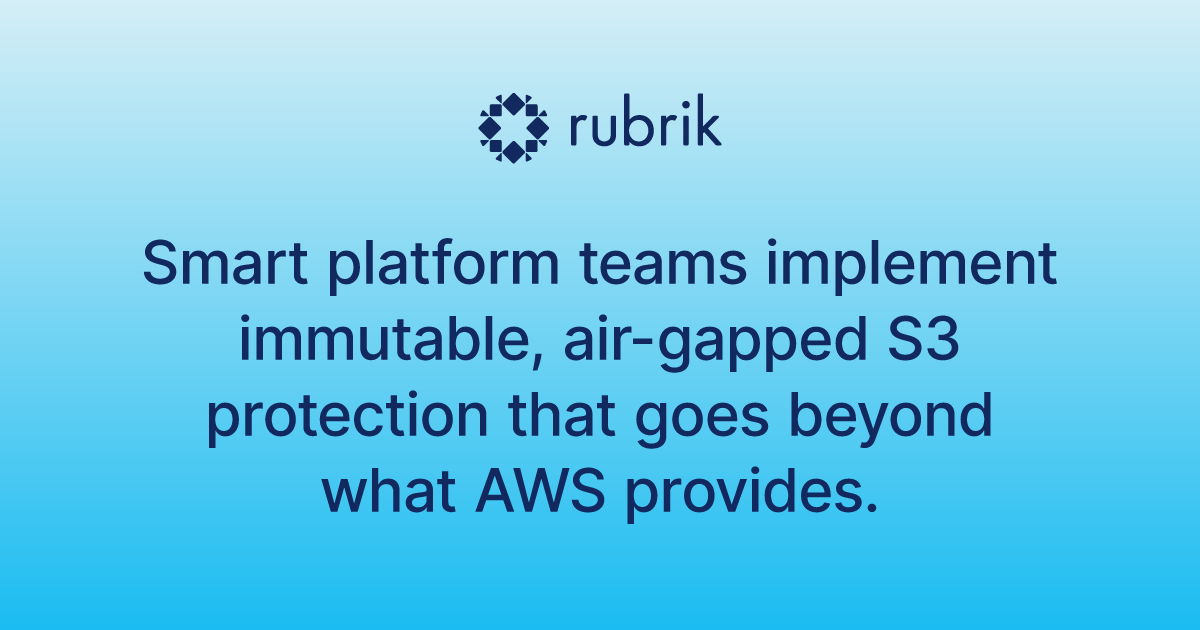Picture this: It's 2 AM when the alerts start flooding in. Core financial applications are failing across the board. Customer-facing systems are throwing errors. Payment processing has ground to a halt. The culprit? A ransomware attack compromised your Amazon S3 data.
If you're responsible for ensuring business continuity and application consistency, this scenario probably makes your stomach drop. And it should— you may have built strong walls around your infrastructure, but those walls don't matter when data gets compromised.
Behind the customer-facing applications of a typical financial services platform are hundreds of microservices, each storing configuration and state data in different S3 buckets. When S3 data gets corrupted or held hostage, it's not just a storage problem. It's an application availability crisis that cascades through your entire financial services operation.
The "Good Enough" Trap That Leaves Apps Vulnerable
Most engineering teams think they're covered. After all, AWS handles infrastructure security, right? And you've got replication across availability zones, multiple versions, or system snapshots. You're good.
Wrong.
AWS secures the infrastructure. You're responsible for protecting the data your applications depend on. And those availability zones, versions, and snapshots? They protect against operational failures, not cyber attacks.
The hard truth: Most teams assume AWS is protecting their application data in S3, only to discover that AWS secures the infrastructure while you're responsible for protecting the data.
The reality is stark: Application recovery investigations take days of manual work coordinating across multiple teams when S3 data gets compromised. It's not just about restoring files. Teams need to figure out which applications are affected, what data they need, and how to restore business functionality. The result: critical customer-facing applications can be down for days.
This confusion about the shared responsibility model is leaving critical financial services applications completely exposed.
The Real Cost of S3 Attacks: It's Not Just About Data
When ransomware hits your S3 buckets, here's what actually happens:
Immediate application failures across your platform: Core financial application systems can't access customer account configurations. Payment rails stop processing because transaction logs are encrypted. Digital lending platforms go offline because loan application data is corrupted.
Manual recovery chaos causes platform team burnout: Engineers get pulled into war rooms, working around the clock to understand application dependencies and coordinate recovery across multiple teams. These incidents can stretch for days, with team members getting called multiple times per night.
Revenue can drop significantly during downtime: In financial services, when applications go down, it's not just about frustrated customers. Revenue typically drops as payment processing fails, loan systems freeze, and customer service platforms crash. Even worse, you start losing customer trust.
Regulatory nightmare scenarios: When auditors ask for seven years of financial records with full audit trails and your S3 data is corrupted or encrypted, compliance becomes your biggest problem.
How Forward-Thinking Platform Teams Rise to the Challenge
The platform engineers who are getting ahead of this aren't just thinking about infrastructure protection. They're thinking about application resilience.
They're asking the right questions:
If our S3 data gets corrupted tomorrow, how quickly can we restore application functionality?
Do we have visibility into which applications depend on which S3 datasets?
Can we recover to a clean point in time that we know is safe from corruption?
Are we prepared for the blast radius when microservices start failing because their S3 dependencies are compromised?
Smart platform teams implement immutable, air-gapped S3 protection that goes beyond what AWS provides. They're building automated sensitive data discovery so they actually know what's in all those S3 buckets. And they're setting up AI-powered anomaly detection to catch threats before they spread.
Most importantly, they're moving from "I hope this doesn't happen" to "I’ll be ready when it happens." That’s a cyber resilience mindset.
The Bottom Line: Your Applications Are Only as Resilient as Your S3 Data
Your applications are the lifeblood of your business. But if the S3 data they depend on isn't protected from cyber attacks, you're building on quicksand.
The question isn't whether you'll face an S3-targeted attack. It's whether your platform team will spend days in crisis mode or mere hours in controlled recovery.
Because at 2 AM, when your core applications are down and your customers can't access their accounts, the strength of your infrastructure walls won't matter if the foundation has crumbled.
Ready to protect what your applications actually depend on? See how Rubrik's Amazon S3 protection helps keep your critical financial services applications available when cyber attacks target your business. See a demo
Any unreleased services or features referenced in this document are not currently available and may not be made generally available on time or at all, as may be determined in our sole discretion. Any such referenced services or features do not represent promises to deliver, commitments, or obligations of Rubrik, Inc. and may not be incorporated into any contract. Customers should make their purchase decisions based upon services and features that are currently generally available.

